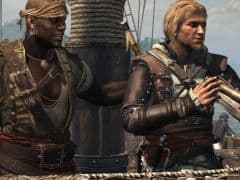Video Gamer is reader-supported. When you buy through links on our site, we may earn an affiliate commission. Prices subject to change. Learn more
Talking at a recent press tour for Black Flag, lead game designer Jean-Sebastien Decant told me that “the biggest challenge for this game was to include [naval combat] in an open world.” Having played the game for over three hours, he’s correctly identified the game’s biggest hurdle. The problem, so far, is that the challenge itself doesn’t seem to have been met.
The demo I played ran over the course of two sequences, showing off both the land and naval combat. It’s the latter which had more focus, and first impressions are good. The sea itself – and your vessel that sits on top of it, the Jackdaw – are nicely rendered. It’s not the best-looking game in the world – something I’ll get to in a bit – but it’s good enough to make you think that you’re cruising the high seas, ready to plunder from all who get in your way.
When you do, however, things take a turn for the worse. Among Edward Kenway’s many interests is securing metal and other goods from Spanish fleets. First, you have to identify your prey using an eyeglass, which also tells you how much bounty is on board, and of which type. After that it’s up to you to attack and board your enemy.
Simple in theory, fiddly and overly-prescribed in practice. Chasing down enemy ships can be fun, as is navigating the Jackdaw through the sometimes challenging environment. But actually attacking and boarding your enemies can be a tedious business that feels a little too much like work.
Each vessel has a health bar, indicating how much more damage it can sustain. A balance must be struck between effective damage and bombardment: too little of the former and you’ll be destroyed attempting to take the craft, too much of the former and you’ll sink it – and its precious cargo.
Sadly, the balance isn’t quite there yet. Sinking your opponent felt too easy, happened too often, and there’s not enough clear feedback as to just how much damage you’re doing (the aforementioned health bar seems rather arbitrary). There’s a lot of chasing, a lot of waiting, and not too much in the way of excitement.
When you’ve nailed the mix however, actually boarding the enemy is enjoyable. You can fire cannonballs from your own deck to thin out the defensive forces, before swinging in Flynn-style to mop up any survivors. What you can’t do, sadly, is board the enemy ship before the game wants you too. I did so without being instructed, wiping out the enemy force. The game told me to head back to my own ship to complete the mission. When I got back there, I had to return to the enemy boat again. Like previous games, this one doesn’t seem to like out-of order execution.
As it stands, it’s frustrating, niggly, and outright fiddly, but then I was playing a build that isn’t finished, and one where my own version of the Jackdaw wasn’t as tuned as it might well be later on in the game (customising it is a big part of the experience). Below the waves, diving for treasure is interesting – avoiding sharks and searching for treasure is a highlight – but, again, limited: you can only really swim in a medium-sized radius from your diving bell. Makes sense, but Ubisoft already utilises a ready-made fix in the shape of air-pocket filled barrels. Not being able to use them far from your bell makes exploration seems artificially limited.
On land, this is the Assassin’s Creed you know, but not much more than that. My time on some of the game’s many islands mostly saw me hunting, or rescuing and recruiting potential crew members to bolster the Jackdaw. The usual sneaking/synchronisation axis is still in effect, with synchro points acting as fast travel locations as well as opening up the map. Eventually, however, you’ll have to engage in combat, which has thankfully been changed from Ass Creed 3’s simplified, mundane affair back to a multi-button combination of strikes, counters, blocks, and guard breaks. As a result it’s far easier to get along with, a boon in game that still hasn’t quite figured out how to make its enemy targeting work when attempting a silent kill.
The sun-and-greenery-covered Bahamian island of Nassau – as well as the smaller, sea-based lands I could sail to and cut around in – seemed far better suited to what Assassin’s Creed should be about than part 3’s historically important but utterly dull Boston setting. In fact, there’s a more playful vibe to the entire game, from the setting to the characters themselves. Nassau itself looks good, but at the same time it wasn’t exactly packed with detail. In fact, the game as a whole never really impresses with regards to it being a next-gen launch title, on PS4 at least.
It’s something that Decant himself acknowledged when we spoke after I played the game. “I think that games that are totally dedicated to next-gen platforms will be stunning. And for the rest, I think that we’ve probably seen [with the] the last three or four generations of consoles, often they have a slow start, so we’ll have to see what next Christmas brings to really judge the next-gen.”
Sadly, Decant and his team don’t have that much time. Assassin’s Creed 4 is an ambitious game that has a lot going for it. But with that ambition comes pressure and expectation. I hope Ubisoft Montreal can manage it, because done correctly this is exactly the sort of entry to get the series back on track. A month before (its current-gen) release, however, and there are some worrying signs to go along with the encouraging ones.
